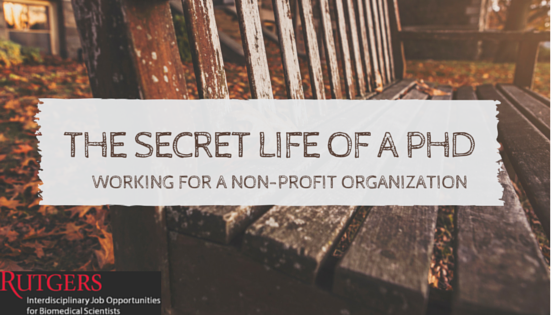By: Maria Qadri
Have you ever looked around and wondered, “Is my research ever going to make an impact?” If you’re interested in impactful research and enjoy building alliances with a purpose, read on.
In March of 2015, we were lucky to have two non-profit organization (NPO) employees serve on a career panel to give us an idea of what the NPO life is like. Alycia Halladay from the Autism Science Foundation and a Rutgers alumna demonstrated one path that began with animal model research that morphed into the singular focus on Autism. Marc Hurlbert from the Avon Foundation laid out an alternative path focusing on more than one disease: in his case, diabetes and then, breast cancer. While both had completed post docs before moving into the world of NPOs, neither said that this was a requirement.
The typical career trajectory for someone with a PhD at an NPO begins as a Scientific Project Officer or Scientific Program Manager, where you would focus on awarding grants to research groups that have the best outcomes and largest impacts to the particular field of interest. If science was a sport, being a scientific project officer is akin to being a knowledgeable fan with a good feeling or an insider tip paired with a penchant for gambling, which is where the deep research skills learned during your dissertation are highly relevant. Much of the job is staying up to date on the science, defining the most promising direction of research, and grant management and tracking. Then, you gradually move up through the ranks of Associate Director of Research, Director of Research, and ultimately Executive Director or CEO of a foundation or organization. Marc emphasized that he still publishes papers jointly with grantees and other researchers, so if you did decide on a different path after trying out the NPO life for a while, several doors would still be open.
The key takeaways from the discussion:
- Day to day, the job is unpredictable, and each day is different than the one before; between meetings, phone calls, reading papers, and ranking grants, the pace is always changing. Contrary to what you might expect, NPOs are very stable places to work since large organizations have prominent and stable financial portfolios. Grant administration is the major task, BUT to keep the overhead low, most employees cover multiple job tasks especially at smaller NPOs. The size and mission of the organization greatly impacts the grant distribution in both number of grants awarded and the monetary amount.
- Alliance building and communication are key! For NPOs, the alliances that need to happen between your key stakeholders: patients, doctors, researchers, and donors. Often, the job involves synthesizing and interpreting research results for stakeholders that may not have a science background. Building alliances within the organization or foundation in which you work are also critical. Be prepared to travel both locally and at a distance: 30-40% of their year consists of travel for networking with donors and attending conferences both near and far.
- Alycia emphasized the double edged sword of the NPO life. Nonprofits are personally fulfilling and have a quantifiable impact to society at large whether it be dollar raised, people helped, or successful grants awarded. The caveat: Don’t be overwhelmed by the warm and fuzzy feelings though – both mentioned that work-life balance is hard to achieve since you are so highly focused on making a difference. The job can be not only emotionally draining, but also the schedule can be demanding and variable.
Both speakers offered essential nuggets of wisdom for the NPO job hunter. Some non-profits favor personal connection to target disease. If you have a connection, at least mention it in your cover letter and interview. This isn’t a requirement but always a perk. Know the organization! A great way to research the organization beyond exploring their website is to find their IRS 990 form to get an idea of how large their portfolio budget is, what their priorities are, and how much your future peers or bosses are bringing home annually. Highlight any side projects and non-science publications. They want highly motivated, passionate, and well-spoken employees. Of course, highlight your critical thinking skills. How else do you expect to demonstrate you can find that leading edge of research? Do something above and beyond daily job tasks. Since they aren’t churning a profit, you stand out by doing more and of course that old cliché – thinking outside of the box. This is one that seems to be universal to any career and is under-utilized by employees. The extra stuff, like helping out without being asked to, will always garner you attention.
Would you consider a career in the non-profit or not-for-profit sector? Do you have any more questions for the insiders?
Useful resources:
The Chronicle of Philanthropy: http://philanthropy.com/
“The Chronicle of Philanthropy is an independent news organization that has been serving leaders, fundraisers, grant makers, and others involved in the philanthropic enterprise for more than 25 years. It offers a robust advice section to help nonprofit workers do their jobs as well as one of the biggest listings of career opportunities.”
START: http://start.org/
“The mission of START is to increase opportunities for research, education and training that strengthen scientific capacities in developing countries to understand, communicate and motivate action on critical global environmental change challenges.”
The Health Research Alliance: https://www.healthra.org/
“The Health Research Alliance fosters collaboration among not-for-profit, non-governmental funders to support the continuum of health research and training from biomedical science applications that advance health.”
